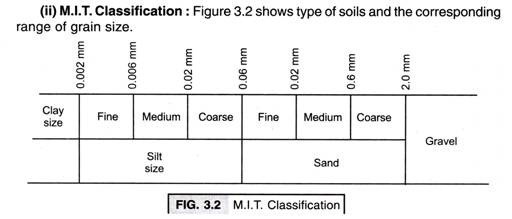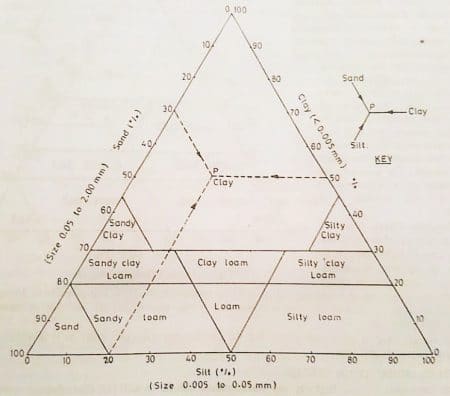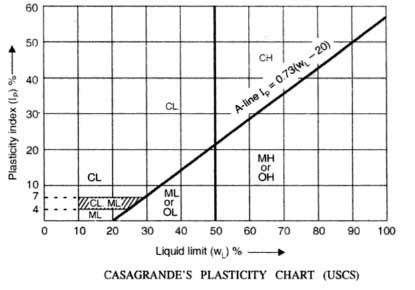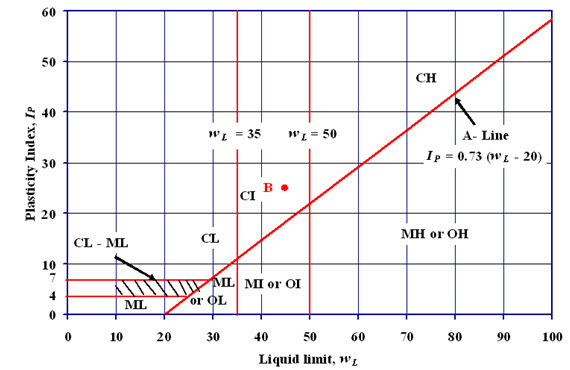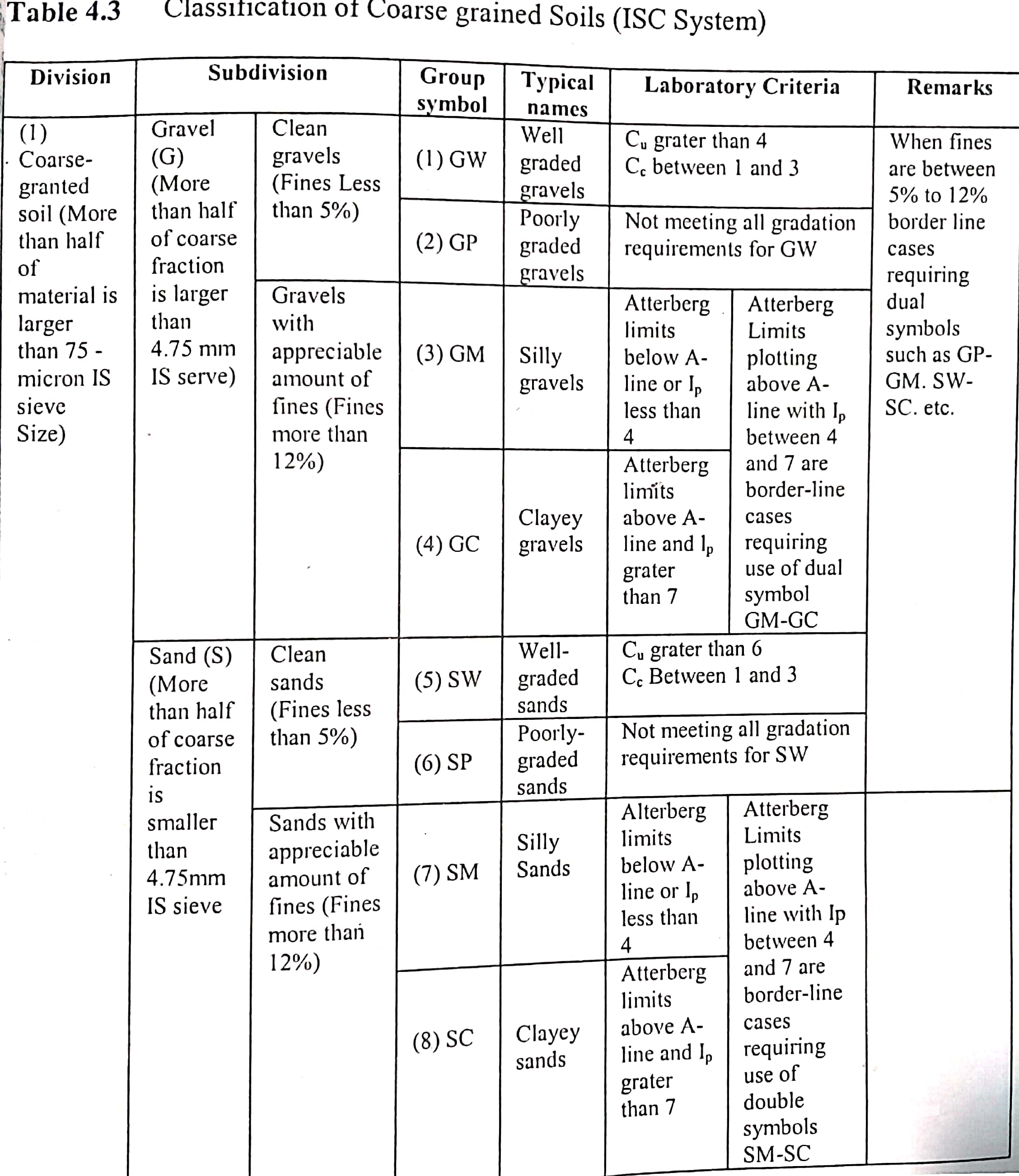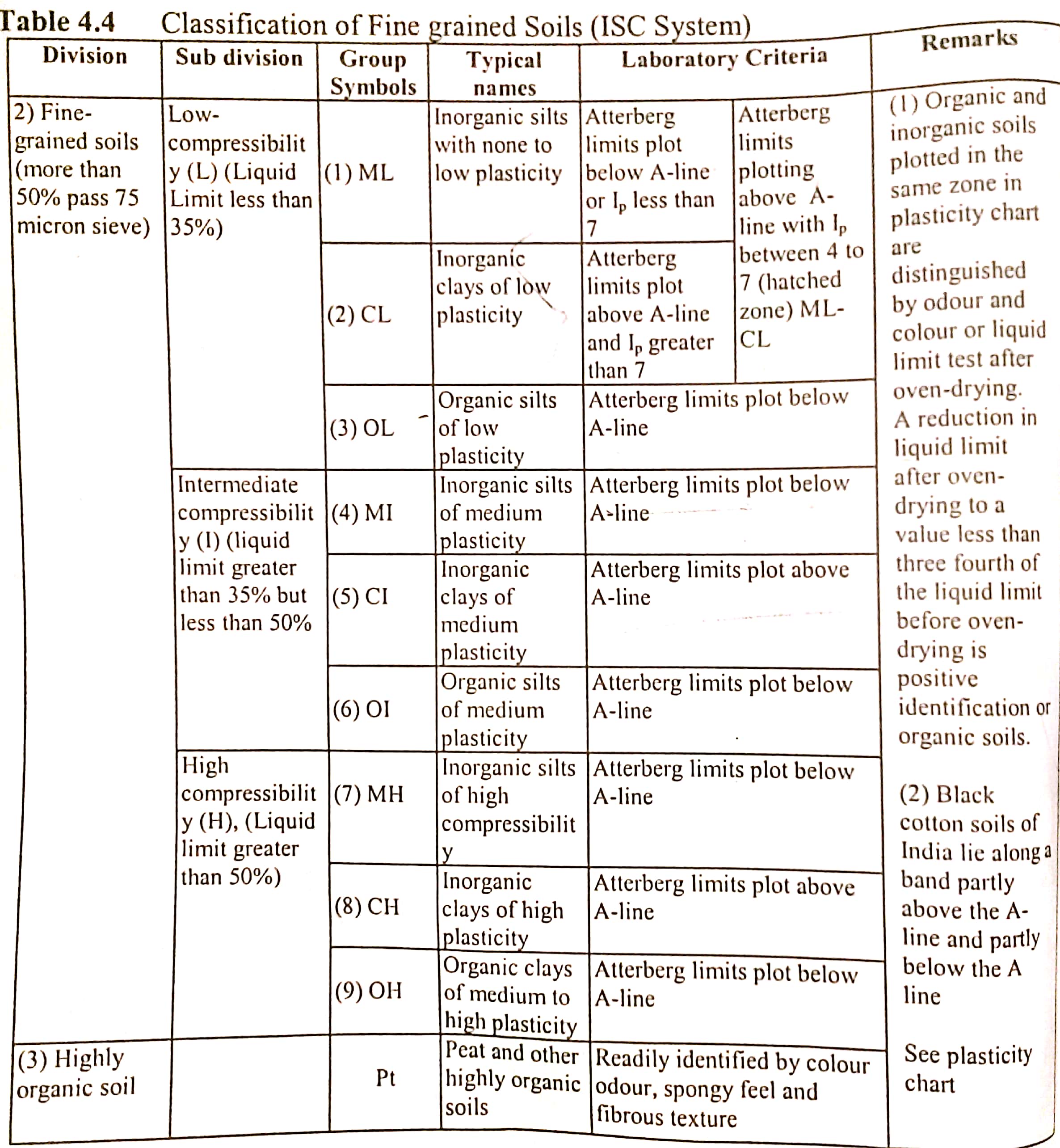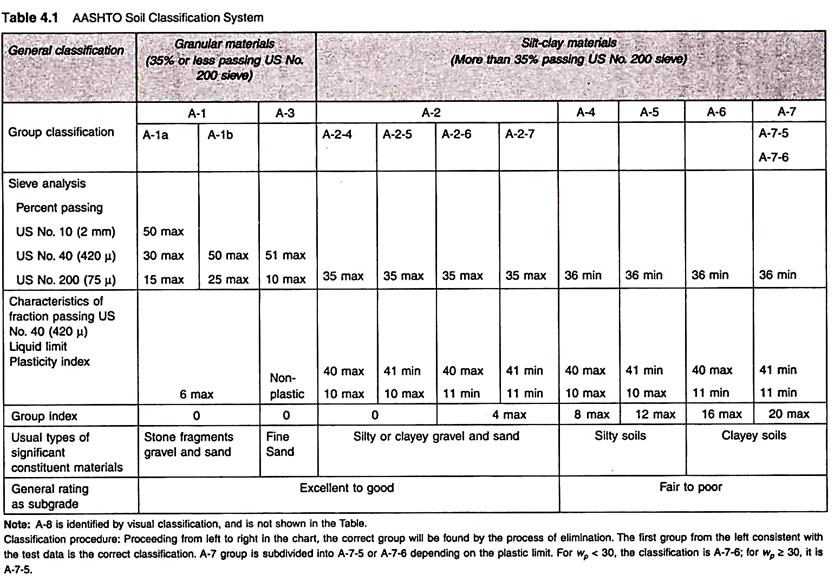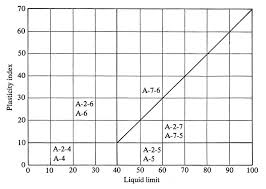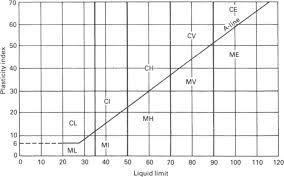Chapter:
1. Explain basic requirement of soil classification.
Soil classification is the arrangement of soils into different groups such that the soils in a particular group have similar behaviour. It is a sort of labelling of soils with different levels.
The main purpose of soil classification is to divide the soil into groups such that all the soil in a particular group has similar characteristics.
Basic requirements of soil classification:
For soil classification system to be useful to the geotechnical engineers, it should satisfy the following basic requirements:
- It should have a limited number of groups.
- It should be based on engineering properties which are most relevant for the propose for which the classification has been made.
- It should be simple and should use the terms which are easily understood.
It is important to describe the arrangement of minor geological details present in a soil as a whole as these details can influence engineering behaviour of the soil to a considerable extent. Features such as layering, fissuring, and inclusions should be described.
2. Explain phenomenon of identification of soils.
The method of identification of soil can be discussed under the heading of coarse grained and fine grained soil materials. Gravel, sand and possibly coarse salts fall into coarse grained varieties and silt and clay fall into fine grained categories.
- Course Grained soil materials (gravel vs sand)
- sand vs silt
- fine grained soil materials (silt versus clay)
Coarse grained soil materials:
The coarse grained soil material are mineral fragments that may be identified primarily on the basis of grain size. The different constituent of coarse grained material are: sand and gravel. The size of sand varies from 0.075 mm to 4.75 mm and that of gravel from 4.75 mm 280 mm. The engineers should have an idea on the relative size of the grains in order to identify soil. If the percentage of gravel is greater than sand then the soil is gravel else sand. The description of sand and gravel should include an estimate of the quantity of material in the different size ranges as well as a statement of the shape and mineralogical composition of the grains.
To identify the coarse grained material, soil samples is first spread on the surface. If more than 50% of the particles are visible to the naked eye, the soil is coarse grained. This is the simple test for the identification of coarse grained materials.
Sand versus silt:
Many times it become difficult to distinguish sand from silt by simple visual examination especially for fine sand. Both the material vendre look like dust except that silt maybe slightly darker in colour than sand. However they can be differentiated by means of dispersion test explained later.
Fine grained soil materials:
The different constituent of fine grained material are silt and clay fraction. Since both these material are microscopic in size, physical properties other than grains size must be used as criteria for field identification.
The classification test using field for preliminary identification are:
- Dry strength test,
- Shaking test (dilatancy test),
- plasticity test (rolling or thread test)(toughness test)
- dispersion test
Dry strength test:
The strength of soil in a dry state is an indication of its cohesion and hence its nature. It can be estimated by crushing of 3 mm size of a dried fragment between Thumb and forefinger. A clay fragment can be broken only with a great effort whereas a silt fragment crushes easily.
Shaking or dilatancy test:
Shaking test it is also called as dilatancy test. It helps to distinguish silt from clay since silt is more permeable than clay. In this test, a part of soil mixed with water to a very short consistency is placed in a Palm of the hand. The surface of the soil is smoothed out with a knife and the soil part is shaken by tapping the back of the hand. If the soil is silt, the water will rise quickly to the surface and give it a shing glistening appearance. If the pat is is then deformed either by squizzing or by stretching, the water will flow back into the soil and leave the surface with a dull appearance. since the clay soil contain much smaller voids than silt and are much less permeable, the appearance of the surface of pat does not change during the shaking test. An estimate of the relative proportions of silt and clay in an unknown soil mixture can be made by noting whether the reaction is Rapid slow or non existence.
Very fine clean sand gives the clearest and most distinguished reaction whereas plastic clay has no reaction. Silt shows a moderately quick reaction.
Toughness test (rolling or thread or plasticity test):
If a sample of moist soil can be manipulated between the palm of the hand and fingers and rolled into a long thread of about 3 mm diameter, the soil then contains a significant amount of clay. However Silt cannot be rolled into 3 mm diameter without Severe cracking.
Dispersion test:
This test is useful for making a rough estimate of sand,silt and clay present in a material. The procedure consist in dispersing a small quantity of the soil in water taken in a glass cylinder and allowing the particles to settle. The coarser particles settle first followed by the finer ones. Ordinarily sand particle settle within about 30 seconds if the depth of water is about 10 cm. Silt particle settle in about 0.5 to 240 minutes where as the particles of clay size remain in suspension for at least several hour and sometimes several days.
The time required for some of the particle size to settle through or 10 cm is given below:
| Particle size (mm) | velocity of fall(cm/sec) | time to settle |
| 2.0 | 360 | 0.03 sec |
| 0.6 | 32 | 0.31 sec |
| 0.2 | 36 | 2.78 sec |
| 0.06 | `324*10^(-3) ` | 30.80 sec |
| 0.02 | `36*10^(-3) ` | 4 min 38 sec |
| 0.002 | `36*10^(-5)` | 7 hr 43 min |
| 0.0002 | `36*10^(-7)` | 32 day 3 hr 36 min |
The table indicates that colloidal particle finer than 0.0002 mm will not generally settle because of Brownian Movement.
3. List various soil classification system.
Soil classification is the arrangement of soils into different groups such that the soils in a particular group have similar characteristics. It is the sort of labelling of Soils with different levels. The major soil classification system are given below:
- Massachusetts institute of Technology system (MIT)
- Texural soil classification system
- Unified soil classification system (USCS)
- Indian soil classification system
- British soil classification system
- AASHTO soil classification system
4. Explain MIT system of classification of soils.
The MIT system of classification of Soils was developed by Professor G.Gilboy at Massachusetts Institute of Technology in USA. In this system, the soil is divided into four group as shown below:
- Gravel: particle size greater than 2 mm.
- Sand: particle size between 0.06 mm to 2 0 mm.
- Silt size: particle size between 0.002 mm to 0.06 mm.
- Clay size: particles size smaller than 0.002 mm.
5. Explain Texural system of soil classification.
US Bureau of soil has developed a triangular classification system, giving different names to soils, containing different percentage of sand, silt and clay size particles, which is known as Textural classification of soil. The chat is shown below.
The first step in the classification of soil is to determine the percentage of sand, silt and clay size material in a given sample by mechanical analysis. With the given relative percentage of sand, silt and clay, a point is located on the triangular chart as shown in the figure. The designation given on the set for the area in which the point falls is then used as the classification of the samples.
This method of classification does not reveal any properties of soil other than grain size distribution. Because of its simplicity, it is widely used by worker in the field of agriculture and Highway Engineering.
One significant disadvantage of this method is that the textural name as derived from the chart does not always correctly express the physical characteristics of the soils. For examples: since some clay size particles are much less active than other, a soil described as clay on the basis of this system may have different physical properties.
6. Explain Unified system of soil classification.
The unified soil classification system was first developed by Casa Grande and modified by the Bureau of Reclamation and crops of engineers of the United State of America.
This system of classification is the most popular one and is universally accepted for classification of soil for general engineering purposes. This system uses both particle size and plasticity characteristics of the soils. Furthermore, the system includes the field identification of soils. In this system, the group symbol letter consists of a primary and secondary descriptive letters. These letters and their meanings are given below:
Some primary letters and their meanings are:
| Symbols | Descriptions |
| G | gravel |
| S | sand |
| M | silt |
| C | clay |
| O | organic |
| `P_t` | peat |
Some secondary letters and their meanings are;
| Symbols | Descriptions |
| W | well graded |
| P | poorly graded |
| M | non-plastic fines |
| C | plastic fines |
| L | low plasticity |
| H | high plasticity |
In this system the Soils are classified into 15 groups. The soils are first classified into two categories
- Cross grained soil and
- fine grained soil
Course grained soils:
The soil is coarse grained,if more than 50% of the soil is retained on the slip of opening 0.075 mm (i.e, number 200 seive). Coarse grained soil is further divided into gravel and sand. If more than 50% of the course particle are retained on number 4 ( i.e, 4.75 mm) sieve, the soil is G. Otherwise termed as S. Gravel and sand are further divided into finer classes depending on the amount of fine particles in the soil.
Listen 5% fines: clean gravel or Clean Sand:
If the coarse grained soil contains less than 5% Fines and are well graded, they are given the symbols GW ( well graded gravel) and SW (well graded sand) and if they are poorly graded (P), they are given the symbols GP (poly graded symbol gravel) and ST (poorly graded sand).
more than 12% fines:
The soil in this category is divided into silty gravel (GM), clayey gravel (GC) or clayey sand (SC), depending on whether the consistency limit of the fine particles are located above the A-line (clayey) or below the A-line (silty) of USCS plasticity chart shown below.
The exact type of soil is determined from plasticity chart. The A-line has the equation `I_p=0.73 (W_l-20)`. It separates the clay from Silt. When plasticity index and liquid limit plots in hatched portion of the plasticity chart, the soil is given by double symbol CL-ML.
The inorganic soil ML and MH and organic soil OL, OH plot in the same zone of plasticity chart. The distinction between organic and inorganic soil is made by oven drying. If the oven drying decreases the liquid limit by 30% or more,the soil is considered organic(OL or OH)otherwise inorganic (ML or MH).
Fines between 5% and 12%:
If the percentage of fines in coarse grained soil is between 5 to 12% dual symbols such as GW-GM (between well graded gravel and silty gravel ), SP-SC (between poorly graded sand and clayey sand).
Fine grained soils:
Fine grained soils are for the divided into two types:
- soils of low compressibility (L) if the liquid limit is 50% or less. These are given by symbols ML, CL,OL.
- soils of high compressibility(H) if liquid limit is more than 50%. These are given by symbols MH,CH,OH.
Organic soils:
Organic soils are fine grained soils with organic characteristics such as strong odour, dark colour, highly compressible and visible presence of organic substances. Depending upon liquid limit, the soil can be organic soil of low plasticity (liquid level smaller than 50% denoted as OL) or Organic soil of high plasticity denoted as OH.
7. Explain Indian Standard Soil classification system.
Indian Standard classification system adopted by Bureau of Indian Standards is in many respect similar to the USCS. However, there is one basic difference in the classification of fine grained soils .The fine grained soils in ISSCS are subdivided into three categories of low, medium and high compressibility instead of two categories of low and high compressibility in USCS.
ISSCS classify the soil into 18 group.
Coarse grained soils:
Coarse grained soils are subdivided into gravel and sand. The soil is termed gravel(G) when more than 50% of course fraction is retained on 4.75 mm IS seive and termed sand (S) if more than 50% of the coarse fraction is smaller than 4.75 mm IS seive. Course graines soils are further subdivided into 8 groups .
Fine grained soils:
The fine grained soil are further divided into three sub divisions, depending upon the values of liquid limit.
Silts and Clay of low compressibility:
These soils have a liquid limit less than 35 (represented by the symbol L).
Silts and Clay of medium compressibility:
These soils have a liquid limit greater than 35 but less than 50 (represented by symbol I).
Silt and Clay of high compressibility
These Soils have a liquid limit greater than 50 (represented by the symbol H).
8. Explain basic differences between AASHTO and USCS soil classification systems.
- According to the AASHTO system, a soil is termed fine-grained if if more than 35% passes through number 200 sieve i.e 0.075mm whereas in the USCS system,a soil is termed fine-grained if more than 50% passes through number 200 sieve. Thus in that sense, the AASHTO system is somewhat better because the soil behaves as fine grained when the percentage of fine is 35% in the limit of 50% in USCS is somewhat higher.
- In AASHTO system, sieve NO.10(2 mm size) is used to divide the soil into gravel and sand where is in USCS sieve NO. 4(4.75 mm) is used.
- In USCS system, the gravelly and Sandy soils are clearly separated where is in AASHTO system, clear demarcation is not done.
- Symbols used in USCS system are more descriptive and are more easily remember than those in AASHTO system.
- Organic soils are classified as OL and OH as peat (`P_t`) if highly organic,in USCS system. In AASHTO system, there is no place for Organic soils.
- USCS system is more convenient to use than a AASHTO system. In AASHTO system, the process of elimination is required which is time consuming.
- AASHTO is for finding out the suitability of soils for highway works only whereas USCS is for finding out the suitability for general purposes.
9. Explain AASHTO system of soil classification.
American Association of state highway and transportation officials classification system is useful for classifying soils for highway this classification is based on following three soil properties:
particle size distribution
liquid limit
plasticity index
This system consists of seven group of inorganic soil, A-1 to A-7 with 12 subgroups in all. A group Index is introduced to identify completely soils containing appreciable fine-grained materials. The higher the value of group index the power is the quality of the material.Group index is given by the following equation:
Group Index,`G.I=0.2a+0.005ac+0.01bd`
Where,
a=The portion of percentage of soil particles passing NO. 200 sieve Greater than 35 and not exceeding 75 expressed as a positive number (0 to 40)=F-35.
b=Portion of percentage of soil particles passing number 200 sieve greater than 15 not exceeding 55 expressed as a positive number (0 to 40)=F-15
c =the portion of percentage of liquid limit greater than 40 in not exceeding 60 expressed as a positive number (0 to 20)=`W_l-40`
d= the portion of the plasticity index greater than 10 in not exceeding 30 expressed as a positive number (0 to 20)=`I_p-10`
The group index is a means of rating the value of a soil as a subgrade material within its own group. It is not used in order to place a soil in a particular group, that is done directly from the results of Sieve analysis, the liquid limit and plasticity index. The higher the value of the group index, the poorer is the quality of the material. The group index is a function of the amount of material passing through the No. 200 sieve, the liquid limit and plasticity index.
If the pertinent index value for soil falls below the minimum limit associated with a, b, c or d, the value of the corresponding term is zero and the term drops out of the group index equation. When the values of a, b, c, d are more than the prescribed maximum values, then the highest value of 40 or 20 should be assigned.The group index value should be shown in parentheses after group symbol as A-6(12) where 12 is the group index .
The classification procedures can be explained from following table:
10. Explain British soil classification system.
The British soil classification system was introduced in British Standard code of practice for site investigation. The qualifying terms are similar to the USCS with more sub-group symbols for both course and fine soils. Poorly graded gravel and sand have been divided into two groups symbol by adding `P_u` and `P_g` to represent uniform and gap graded soil respectively. In course soils sub-groups have been defined by adding a third letter (M or C) to well graded or poorly graded gravel and sand. Following terms have been used in the classification system:
Terms | Symbols | Meanings |
Gravel | G | Well graded |
Sand | S |
|
Fine soils,fines | F | Low plasticity(`W_l < 35`) |
Silts | M | Intermediate plasticity(`W_l =35- 50`) |
Clay | C |
|
Peat | `P_t` | Organic |
The letter denoting the dominant size fraction is placed first in the group symbol. If a soil has a significant content of organic matter, the suffix O is added as the last letter of the group symbol. A group symbol may consist of two or more letters. For example:
Symbols | Meanings |
SW | Well graded sand |
SCL | Very clayey sand (clay of low plasticity) |
CIS | Sandy clay of intermediate plasticity. |
MHSO | Organic sandy silt of high plasticity. |
 Guest
Guest

